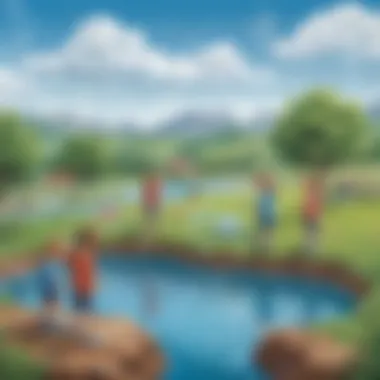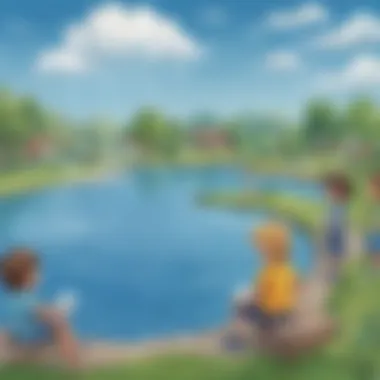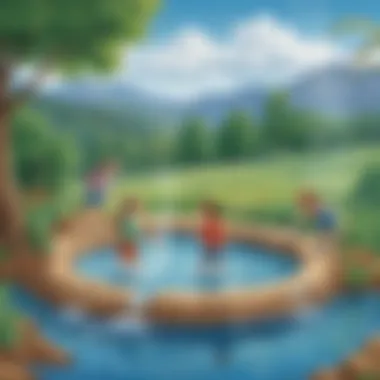Engaging Water Cycle Activities for Kindergarten Learners


Fun Activities Ideas
Water cycle activities for kindergarten children can be both educational and entertaining. Engaging in hands-on activities helps kids understand the vital concept of the water cycle in an enjoyable manner. From conducting science experiments to creating artistic masterpieces, these activities are designed to stimulate curiosity and foster a deep connection with the natural world.
Indoor Activities
Indoor water cycle activities can be a wonderful way to explore and learn, especially on rainy days or during cold weather. Inside the cozy confines of the classroom or home, children can create mini water cycle terrariums to observe the process up close. By setting up simple condensation experiments using household items like bowls and plastic wraps, kids can witness firsthand how water transforms from vapor to liquid.
Outdoor Adventures
Taking the learning outside can add a sense of adventure to understanding the water cycle. Visiting local ponds or streams allows children to observe the natural water cycle in action. They can splash in puddles, watch clouds form, or even collect rainwater to see the cycle's elements come together. Outdoor exploration not only educates but also instills a sense of wonder about the world around us.
Arts and Crafts
Artistic water cycle activities help kindergarteners express creativity while learning. From crafting paper plate water cycles to painting rainbows to depict the hydrologic cycle, there are plenty of artistic ventures to undertake. Involving colors, textures, and creative imagination, arts and crafts projects around the water cycle engage multiple senses and promote imaginative thinking.
Science Experiments
Science experiments offer a hands-on approach to comprehending the complexities of the water cycle. Conducting experiments like making clouds in a jar or crafting mini water cycles in plastic bags allows children to interact directly with scientific concepts. These experiments not only teach scientific principles but also enhance problem-solving skills and critical thinking abilities.
Cooking and Baking
Incorporating cooking and baking activities into water cycle lessons can broaden children's understanding in a tasty way. By making edible water cycle models with blue gelatin representing water bodies, whipped cream as clouds, and gummy candies for rain, kids can visually and gastronomically experience the water cycle in action. Cooking not only teaches about the cycle but also enhances measuring, following instructions, and teamwork skills.
Introduction
In this pioneering article, we embark on a captivating journey into the realm of water cycle activities tailored specifically for kindergarten-aged children. The significance of introducing young minds to the intricate concepts of the water cycle through engaging and interactive experiences cannot be overstated. By delving into a range of hands-on experiments and creative projects, these activities aim not only to educate but also to foster a sense of wonder and curiosity towards the natural world. Exploring the water cycle at an early age sets a solid foundation for environmental awareness and scientific exploration.
Overview of the Water Cycle


Definition of the Water Cycle
Unraveling the enigmatic nature of the water cycle, we immerse ourselves in the fundamental definition that underpins this crucial natural process. The water cycle represents the continuous journey of water through various states - from evaporation to condensation and precipitation. Understanding this perpetual cycle is paramount as it elucidates the interconnectedness of Earth's systems and highlights the significance of conservation efforts. By dissecting each phase of the water cycle, children can grasp the essence of sustainability and the importance of preserving this precious resource.
Importance of Understanding the Water Cycle
Exploring the importance of comprehending the water cycle unveils its pivotal role in our ecosystem. A profound understanding of this cycle not only enriches scientific knowledge but also nurtures a sense of responsibility towards environmental stewardship. In delving into the intricacies of evaporation, condensation, and collection, young learners develop a profound appreciation for the interconnected web of natural processes. Consequently, instilling a comprehensive understanding of the water cycle lays the groundwork for conscious water usage and conservation practices among the future custodians of our planet.
Significance of Early Education on the Water Cycle
Benefits of Introducing Water Cycle Concepts Early
Unveiling the benefits of early exposure to water cycle concepts illuminates the transformative power of early education. By introducing youngsters to the water cycle at a formative age, we not only stimulate their scientific curiosity but also cultivate a sense of environmental consciousness. Empowering children with the knowledge of how water sustains life and interacts with the environment instills a sense of awe and respect for nature's delicate balance. The early introduction of water cycle concepts equips children with a holistic understanding of natural processes, nurturing a generation of eco-conscious individuals poised to safeguard our planet's future.
How Kindergarten Activities Can Aid in Comprehension
Exploring how kindergarten activities serve as catalysts for comprehension sheds light on the pedagogical significance of interactive learning. By seamlessly integrating water cycle concepts into engaging activities, educators can enhance children's comprehension and retention levels. Through hands-on experiments, visual aids, and exploratory play, kindergarten activities transform abstract concepts into tangible experiences, thereby deepening children's understanding of the water cycle. These activities not only facilitate conceptual grasp but also stimulate curiosity, creativity, and critical thinking skills essential for lifelong learning.
Hands-On Activities
In this article, the hands-on activities play a crucial role in engaging kindergarten children with the intricate concept of the water cycle. Through tactile experiences and interactive learning, young learners can develop a deeper understanding of the natural processes around them. These activities not only educate but also spark curiosity and foster a sense of wonder in the minds of the children. By incorporating hands-on elements, such as experiments and art projects, the children can actively participate in their learning journey, making the educational process more engaging and effective.
Creating a Water Cycle Model
Materials required for the project
When embarking on the creation of a water cycle model, several materials come into play to bring this educational project to life. Items such as transparent containers, shaving cream, food coloring, and a heat source are essential for simulating the evaporation, condensation, and precipitation stages of the water cycle. These materials not only aid in visualizing the scientific processes but also provide a hands-on approach to learning. Their versatility in showcasing the water cycle phenomena makes them a popular choice for educators aiming to make complex concepts understandable for young minds. The unique feature of these materials is their ability to transform abstract ideas into tangible experiences, enabling children to grasp the complexities of the water cycle through interactive demonstrations.
Step-by-step guide to building the model
The step-by-step guide to building a water cycle model outlines a structured approach to creating a visual representation of the natural water cycle process. Starting with filling the container with water to simulate bodies of water on Earth, adding heat to induce evaporation, and using shaving cream clouds to represent condensation, each step guides the children through a hands-on exploration of the water cycle. This methodical process not only educates but also engages the children in active participation, reinforcing their understanding of the scientific concepts involved. The guide's unique feature lies in its ability to break down complex phenomena into manageable steps, making the learning experience accessible and enjoyable for kindergarten children. Its hands-on nature encourages experiential learning, allowing young learners to connect theory with practice seamlessly.


Art and Craft Projects
Art and Craft projects play a pivotal role in this article, offering young learners a creative outlet to explore and understand the water cycle. By engaging in hands-on artistic activities, children can visualize abstract concepts in a tangible manner, fostering a deeper connection to scientific principles. These projects not only enhance cognitive development but also encourage exploration and experimentation, key components of early education.
Water Cycle Collage
Instructions for creating a collage:
The Water Cycle Collage activity provides a visual representation of the water cycle stages, allowing children to piece together the process in a creative way. Instructing children on how to cut, paste, and arrange different elements of the water cycle instills a sense of accomplishment and reinforces learning. This activity aids in improving fine motor skills and spatial awareness, essential for young children's development.
Discussion on different water cycle stages to include:
Including different water cycle stages in the collage prompts conversations about evaporation, condensation, precipitation, and collection. Discussing these stages while creating the collage helps children grasp the interconnectedness of natural processes. By incorporating all stages, children gain a comprehensive understanding of how water moves through the environment, linking scientific knowledge with artistic expression.
Painting Raindrops
Materials needed for the art project:
The Painting Raindrops activity requires watercolor paints, paper, and brushes, enabling children to explore the creative aspect of raindrops. By using different colors and techniques, children can express their interpretation of raindrops, fostering individuality and artistic expression. This project emphasizes the beauty of nature and encourages children to observe closely and replicate the intricate patterns found in rain.
Encouraging creativity through raindrop art:
The activity of painting raindrops encourages children to think imaginatively and experiment with colors and shapes. By allowing creative freedom in depicting raindrops, children learn to appreciate the aesthetics of nature and develop their artistic skills. Encouraging creativity through art promotes self-expression and boosts self-confidence in young learners.
Clay Creations: Water Cycle Scene
Tips for sculpting a water cycle landscape:
Sculpting a water cycle landscape with clay provides a tactile experience, allowing children to mold and shape different elements of the cycle. By following step-by-step instructions, children can create a three-dimensional representation of the water cycle, enhancing spatial reasoning and creativity. This activity emphasizes attention to detail and precision, enhancing children's focus and concentration.
Promoting fine motor skills through clay work:


Engaging in clay work promotes the development of fine motor skills as children manipulate and mold clay to create the water cycle scene. Pinching, rolling, and shaping clay enhance dexterity and hand-eye coordination, crucial for later academic tasks. Through clay work, children improve their sensory skills and tactile sensitivity, fostering holistic development.
Interactive Games
Interactive games play a crucial role in engaging young learners and enhancing their understanding of complex topics like the water cycle. By incorporating games into the learning process, children can interact with the information in a fun and interactive way, making the concepts more memorable. In this article, the section on interactive games aims to provide a hands-on approach to consolidating knowledge about the water cycle through a playful medium. By offering activities that promote critical thinking, memory retention, and problem-solving skills, these games form an integral part of the educational experience for kindergarten-aged children.
Water Cycle Memory Match
How to play the memory game
Playing the water cycle memory match game involves flipping cards to find matching pairs related to the water cycle. This activity not only improves visual memory but also helps children associate different stages of the water cycle with corresponding images or descriptions. It aids in fostering concentration, cognitive skills, and knowledge retention. The simplicity of the game's mechanics ensures accessibility for young learners, making it an effective tool for reinforcing learning in a playful manner within the context of the water cycle exploration for kindergarteners.
Benefits of memory games in reinforcing learning
Memory games serve as a valuable tool for reinforcing learning by stimulating cognitive functions, enhancing memory recall, and promoting concentration. In the context of exploring the water cycle with kindergarten children, memory games help solidify the different components and stages of the water cycle in a engaging manner. By actively engaging in the process of matching images or concepts, children are encouraged to retain information while enjoying the interactive aspect of the game. Additionally, memory games offer a structured approach to revisiting key elements of the water cycle, ensuring comprehensive understanding and retention of the topic.
Puzzle: Journey of a Water Droplet
Creating a water cycle puzzle
Creating a water cycle puzzle involves designing a puzzle that illustrates the journey of a water droplet through various stages of the water cycle. This hands-on activity not only encourages creativity but also provides a visual representation of the complex process of water circulation on Earth. The puzzle serves as an interactive tool to stimulate curiosity and facilitate discussions around the significance of each stage in the water cycle, offering a tangible way for children to grasp the interconnected nature of this natural phenomenon.
Engagement through solving the puzzle
Solving the water cycle puzzle promotes engagement by allowing children to actively participate in piecing together the sequence of events in the water cycle. This interactive experience fosters problem-solving skills, spatial reasoning, and collaboration among peers. Through the process of assembling the puzzle, children gain insights into the intricate dynamics of the water cycle while enhancing their critical thinking abilities. The puzzle serves as a dynamic educational tool that encourages exploration and discovery, making it a valuable addition to the array of activities aimed at promoting an in-depth understanding of the water cycle for young learners.
Conclusion
Reflecting on the Learning Experience
Recap of Key Activities and Their Impact
Reflecting on the key activities included in this water cycle exploration, we observe a remarkable emphasis on practical engagement and experiential learning. The hands-on projects such as creating water cycle models, DIY rain clouds, and sensory bins offer children direct interactions with scientific concepts in a tangible way. The impact of these activities goes beyond mere memorization as children develop a deeper comprehension of the water cycle dynamics. A notable characteristic of these activities is their ability to cater to various learning styles, making them a versatile and effective choice for enhancing comprehension in young learners. The unique feature of these hands-on experiences lies in their capacity to stimulate creativity, critical thinking, and sensory exploration, further enhancing the overall learning experience.
Encouraging Continuous Exploration of the Water Cycle
Encouraging continuous exploration of the water cycle postulates a crucial aspect of nurturing a lifelong love for learning in children. By fostering a sense of curiosity and wonder about the natural world, young learners are motivated to delve deeper into scientific phenomena such as the water cycle. The continuous exploration serves not only to reinforce existing knowledge but also to instill a sense of environmental consciousness and appreciation for nature. An essential characteristic of this approach is its promotion of independent inquiry and hands-on investigation, allowing children to take ownership of their learning journey. The unique feature of encouraging continuous exploration is its capacity to instill a sense of wonder and excitement in children, creating a foundation for lifelong learning and scientific curiosity.



